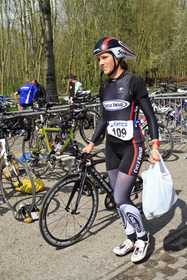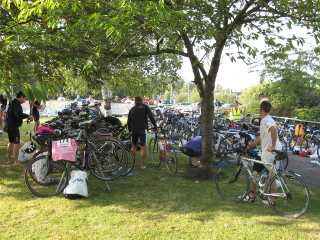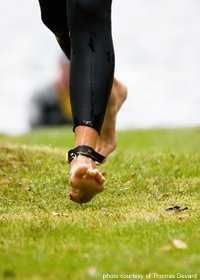Triathlon Transition
The Fourth Discipline
Why the fourth discipline?
The importance of the triathlon transition stages cannot be over estimated. Valuable time that you have gained through quality training can easily be lost by lack of preparation for the triathlon transition.
By including this in your training, you will find that it will become second nature during the race resulting in less stress and time gained.

Make sure that you are completely prepared, with bag packed, the day before your race. Also check that everything is working properly. Here's an example of why it is so important!
In one race that Jan and I were doing, the swim start was a half mile walk along a river bank, during which we did up our wetsuits.
I had forgotten to check out my wetsuit beforehand only to discover that the zip had jammed to such an extent that it was impossible to do up.
With a freezing cold river, I had to do the swim with my wetsuit constantly coming over my shoulder. Not recommended!
On race day, make sure that you arrive in plenty of time. With pre race nerves kicking in you want to allow for getting a parking space and getting all your kit to the triathlon transition area.

Once there you will check in and be allocated your race number, if you don't already have it.
You will then make your way to the transition area, during which time you will probably have your race number written on your arms and legs.
You will then find your bike slot and start setting out your kit. Try to find a point that you will be able to focus on during the race, such as a banner, post or tree to enable you to spot your bike quickly.
With many swimmers exiting the water and cyclists running with their bikes, the transition area can become a little chaotic, and this will help you locate your bike.

One of the first things you should do is wrap the timing chip band around your ankle. If you are competing with a friend, be very careful not to inadvertently confuse your chip bands.
I say this because, once, I was competing in a 10km road race with a female friend and we somehow swapped chip bands. I ended up coming second lady in her age group!
Also make sure that you have walked the swim/bike and the bike/run transitions so that you know exactly where you are going. It is easy to get disorientated when tired and in unfamiliar surroundings.
Lay your gear out exactly as you want it. Towel by your bike, race belt, cycle shoes and/or trainers, cycle helmet and sunglasses. Water/energy drink and energy bars already on your bike. A hat may be useful for the run if it is really hot.
Make sure your bike is in the right gear before you rack it. Attach your race number to it. Hopefully, you will have cycled the course in training so you will know which gear to be in for that particular start.
For instance, the Fowey Triathlon in Cornwall starts up, what seems like, a 1 in 2 hill which would therefore need a lower gear than a flat start.
Give yourself more than enough time for all these preparations. Once your kit is prepared you can relax and start mentally preparing yourself for the race.
Competitors will very likely be called in for pre race instructions by the race director and then you will be ready for the off. Good luck!
Membership of the Triathlon Club is FREE!
Please join us by signing up for our newsletter which will tell you each month about information we have added to the website!